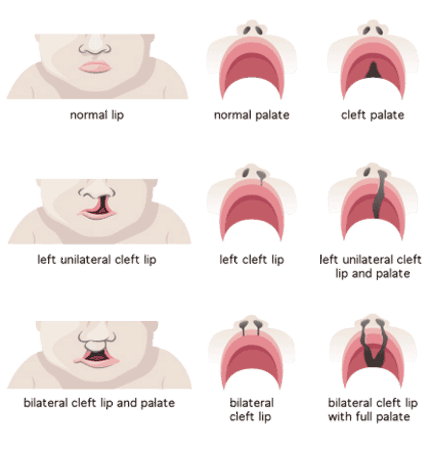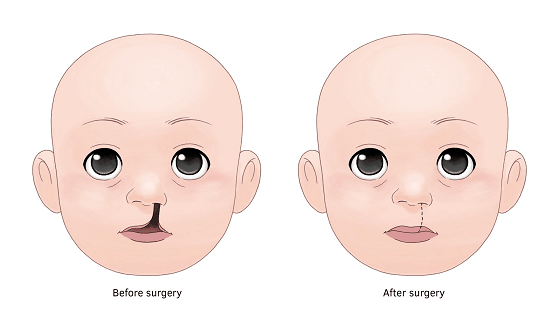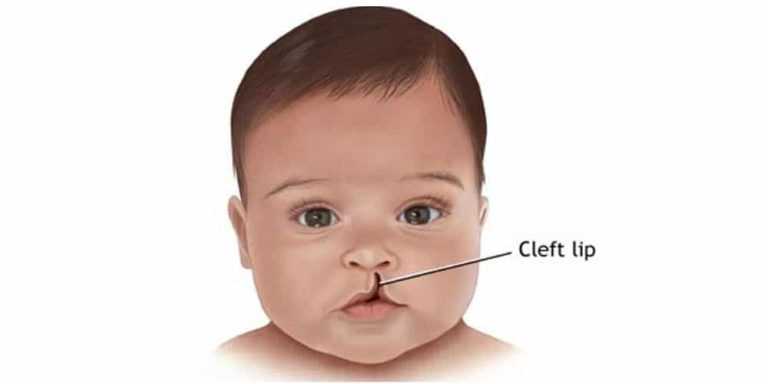Overview
The cleft lip and palate are the openings or parts in the upper lip, the highest point of the mouth (sense of taste), or both. This problem occurs when facial structures that are made in an unborn kid don’t close completely.
Cleft lip and palate are among the most widely recognized birth faults. They most regularly happen as separated birth faults but on the other hand, are related to many acquired hereditary conditions or different disorders.
Having a child brought into the world with a cleft can be upsetting, however this issue can be adjusted. In many children, a progression of medical procedures can reestablish typical capacity and accomplish a progressively ordinary appearance with negligible scarring.

Symptoms of Cleft lip and palate
Normally, a split (cleft) in the lip or sense of taste is promptly recognizable during childbirth. Cleft lip and palate may show up as:
- A split in the lip and top of the mouth (sense of taste) that influences one or the two sides of the face
- A split in the lip that shows up as just a little score in the lip or stretches out from the lip through the upper gum and sense palate into the base of the nose
- A split in the top of the mouth that doesn’t influence the presence of the face
Less ordinarily, a cleft happens just in the muscles of the delicate sense of taste, which are at the rear of the mouth and secured by the mouth’s coating. This sort of parting regularly goes unnoticed during childbirth and may not be analyzed until later when signs are created. Signs and indications of submucous cleft palates may include:
- Trouble with feedings
- Trouble gulping, with the potential for fluids or nourishment to come out of the nose
- Nasal talking voice
- Constant ear diseases
When to see a dental specialist
A cleft lip and palate are typically seen during childbirth, and your primary care physician may begin organizing care around them. On the off chance that your infant has signs and manifestations of a sub mucous cleft palate, make a meeting with your kid’s dental specialist
Causes
Cleft lip and cleft palate happen when tissues in the endearing face and mouth don’t combine appropriately. Typically, the tissues that make up the lip and sense of taste meld in the second and third long stretches of pregnancy. Be that as it may, in babies with cleft lip and cleft palate, the combination never happens or happens just part way, leaving an opening (cleft).
Specialists accept that most instances of cleft lip and cleft palate are brought about by a collaboration of hereditary and ecological elements. In numerous infants, a clear reason isn’t found.
Risk factors
A few elements may improve the probability of an infant building up a cleft lip and palate, including:
- Family history- Parents who have the problem of cleft lip and cleft palate face a higher danger of having a child with a separation.
- Presentation of specific substances during pregnancy. Cleft lip and palate might be bound to happen in pregnant ladies who smoke cigarettes, drink liquor, or take certain prescriptions.
- Having diabetes. There is some proof that ladies determined to have diabetes before pregnancy may have an expanded danger of having an infant with this problem.
Prevention
After an infant is brought into the world with a separation, parents are naturally worried about the chance of having another youngster with a similar condition. While numerous instances of cleft lip and palate can’t be forestalled, consider these means to build your comprehension or lower your risk:
- Think about hereditary guiding. On the off chance that you have a family history of the problem, tell your doctor before you become pregnant. Your doctor may suggest you to a hereditary guide who can help decide the danger of having youngsters with this problem.
- Take pre-birth nutrients. In case you’re intending to get pregnant soon, inquire as to whether you should take pre-birth nutrients.
- Try not to utilize tobacco or liquor. Utilization of liquor or tobacco during pregnancy expands the danger of having an infant with a birth imperfection.
Finding
Most instances of congenital fissure and congenital fissure are seen immediately during childbirth and don’t require uncommon tests for finding. Progressively, congenital fissures and congenital fissures are seen on ultrasound before the infant is conceived.
Ultrasound before birth
A pre-birth ultrasound is a test that utilizations sound waves to take photos of the creating baby. While breaking down the photos, a specialist may identify a distinction in the facial structures.
Congenital fissures might be recognized with ultrasound starting around the thirteenth seven-day stretch of pregnancy. As the embryo keeps creating, it might be simpler to precisely analyze a congenital fissure. A congenital fissure that happens alone is progressively hard to see utilizing ultrasound.
If a pre-birth ultrasound shows a split, your primary care physician may offer a technique to take an example of amniotic liquid from your uterus (amniocentesis). The liquid test may demonstrate that the embryo has acquired a hereditary condition that may cause other birth abandons. In any case, regularly the reason for congenital fissure and congenital fissure is obscure.
Treatment

The objectives of treatment for congenital fissures and congenital fissures are to improve the kid’s capacity to eat, talk, and hear regularly and to accomplish a typical facial appearance.
Care for youngsters with congenital fissure and congenital fissure regularly includes a group of specialists and specialists, including:
Specialists who spend significant time in split fix, for example, plastic specialists or ENTs
- Oral specialists
- Ear, nose, and throat specialists (ENTs, likewise called otorhinolaryngologists)
- Pediatricians
- Pediatric dental specialists
- Orthodontists
- Medical caretakers
- Sound-related or hearing pros
- Language instructors
- Hereditary advocates
- Social specialists
Therapists
Treatment includes medical procedures to fix the deformity and treatments to improve any related conditions.
Expert opinion
- Dr. Rupali Gujar Dental Director of Sabka dentist says “Surgery can fix cleft lip and palate seen in children by seeing a dental expert or a pediatric dentist.”










